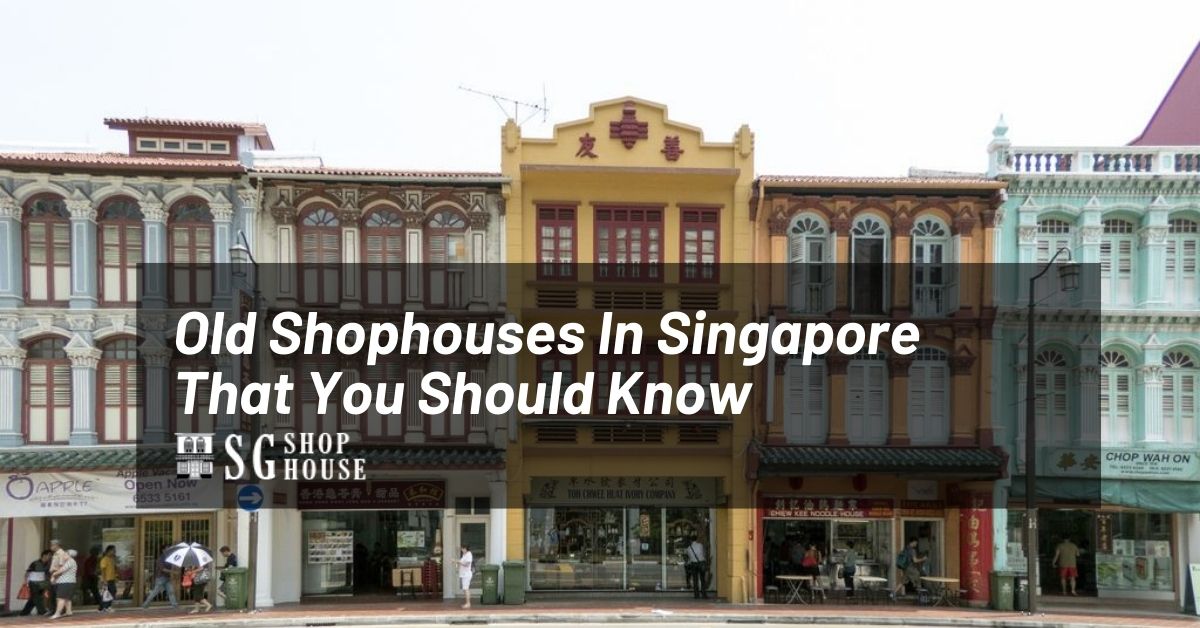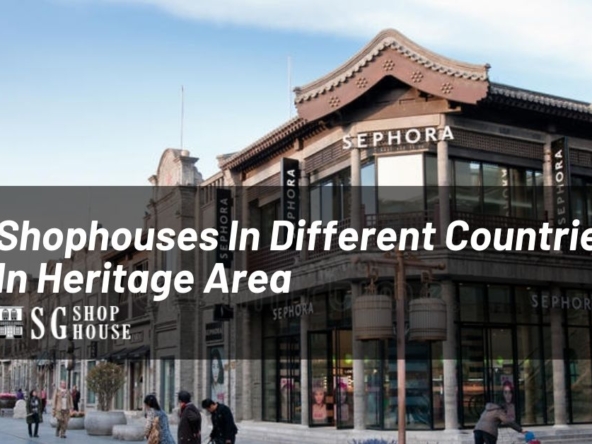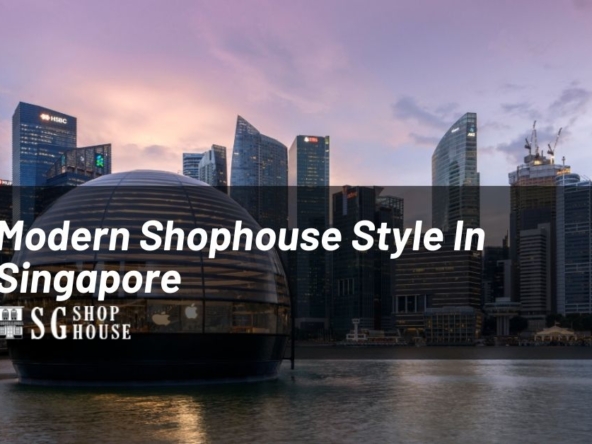The Historic District of Chinatown comprises four distinct sub-districts: Telok Ayer, Kreta Ayer, Bukit Pasoh and
Tanjong Pagar. This article introduces the history and character of the area and explains its growth from the 1820s. When it began as the first settlement of immigrants from southern China and southern India, until the immediate post-World War II period. Together with the other precincts south of the Singapore River, they made up what was known colloquially as the Greater Town (or Da Po, 大坡) of Singapore. Because of its architectural, historical, and social importance, the area given conservation status on 7 July 1989. Here is the Old Shophouses In Singapore That You Should Know.
Old Shophouses In Singapore: Kreta Ayer
The Malay name Kreta Ayer (or Niu Che Shui, 牛车水) comes from the ox-drawn water carts that used to deliver water to the area. In the 19th century, this predominantly Cantonese area known for round-the-clock entertainment with a concentration of teahouses, opera theatres, and brothels. Today it is best known for its Chinese New Year and Mid-Autumn celebrations, street market and bustling atmosphere.
1.Former Great Southern Hotel 旧南天大酒店
Address: 70 Eu Tong Sen Street
This former hotel designed by architectural firm Swan & Maclaren and was once regarded as the Raffles Hotel of Chinatown. Popular with high society including celebrities from Hong Kong and China, it was once the tallest building in the area and was the first Chinese hotel in Singapore to boast a lift service.
2.Old Shophouses In Singapore: Former Majestic Theater 旧大华大戏院
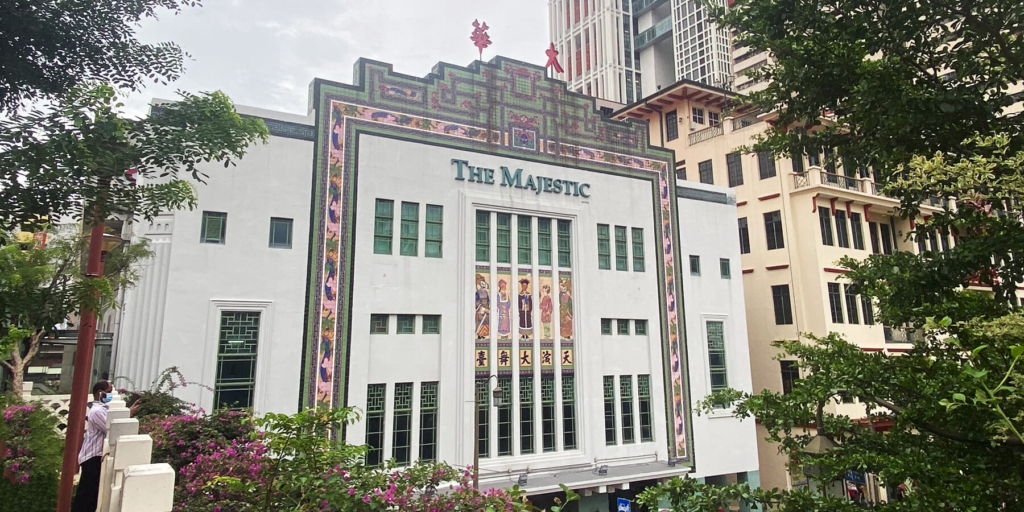
Address: 80 Eu Tong Sen Street
This was originally a Cantonese opera house built by philanthropist Eu Tong Sen in 1927 for his wife after she reportedly refused admittance to an opera performance elsewhere. A highlight of this Art Deco building is its decorated façade of hand-painted tiles depicting opera characters and flying dragons.
3.Former Lai Chun Yuen 旧梨春园
Address: 25 Trengganu Street
Built-in 1887, this three-storey former theatre building with unique cantilevering wooden balconies was the centre of entertainment in Kreta Ayer until it badly damaged during World War II. Its popularity was such that surrounding streets colloquially named after the theatre itself. Smith Street was Theater Street, Temple Street
was Theater Rear Street, and Trengganu Street was Theater Side Street.
Old Shophouses In Singapore: Telok Ayer
Old Shophouses In Singapore: Telok Ayer, Malay for Water Bay, is the oldest sub-district. It started to develop in the 1820s and remained as the key Chinese commercial district until the late 19th century. The population in this area was predominantly Hokkien. The area often associated with the laid-back atmosphere of Ann Siang Hill, and the religious buildings along Telok Ayer Street.
1.EU YAN SANG 余仁生
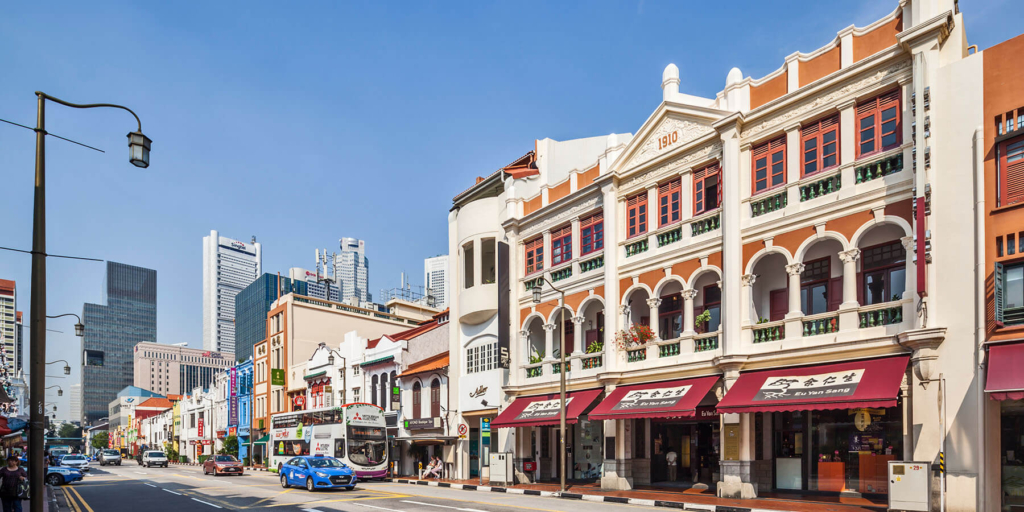
Address: 267 to 271 South Bridge Road
Built-in 1910, this is the first Eu Yan Sang outlet in Singapore set up by Eu Tong Sen. Besides dealing in the retail
of traditional Chinese medicine, it used to offer money remittance services to China. The building designed by
Alfred Bidwell from the firm Swan & Maclaren. He was also responsible for the design of the Raffles Hotel and
Victoria Memorial Hall.
2.Old Shophouses In Singapore: Clan and Trade Associations
Address: Ann Siang Road and Club Street
Clan and trade associations were important institutions for mutual assistance in 19th and early 20th century Singapore as they helped new immigrants from China settle down and looked after their welfare. Along Ann Siang Road and Club Street are numerous clan and trade associations were stepping into one, time seems to stand still. Some still retain their meeting halls filled with portraits of members from the past and century-old furniture. Some of these associations can found. For example, at 17 (Ching Yoon Wooi Kwoon) and 25 (Kwong Wai Siew Li Si She Shut) Ann Siang Road, and 84 Club Street (Nam Sun Wui Kun).
Old Shophouses In Singapore: Bukit Pasoh
Bukit Pasoh developed at the turn of the 20th century as an extension of the already densely populated Telok Ayer and Kreta Ayer areas. Its name means Pot Hill in Malay, referring to its origins as a place where earthen pots made. Its charm lies in its gently sloping and curving streets fronted by shophouses that house a mixture of institutional and commercial activities.
1.Poon Yue Association 番禺会馆
Address: 281 New Bridge Road
Old Shophouses In Singapore: The association founded in 1879 at Upper Cross Street with financial assistance from Hoo Ah Kay. A well-known community leader from the Whampoa district in Guangdong province. The association relocated to New Bridge Road in 1917. The building is a hybrid of NeoClassical and Art Deco styles which were popular with Chinese developers in the past who wanted to project a modern image. To the Chinese, New Bridge Road colloquially referred to as Da Po Er Ma Lu, Mandarin for Greater Town’s Second Road. In fact, the first road referred to in this instance
was South Bridge Road.
2.Old Shophouses In Singapore: Kong Chow Wui Koon 冈州会馆
Address: 321 New Bridge Road
This Cantonese clan association was established in 1839 at Upper Chin Chew Street and moved in 1924 to the present building, designed by Westerhout & Oman. During the Japanese Occupation, the custodians volunteered the building as a clinic and hence its antique interiors remained intact. The association is well known for its lion dance
troupe and martial arts. This is one of Chinatown’s first community museums and entry is free.
3.Ee Hoe Hean Club 怡和轩俱乐部
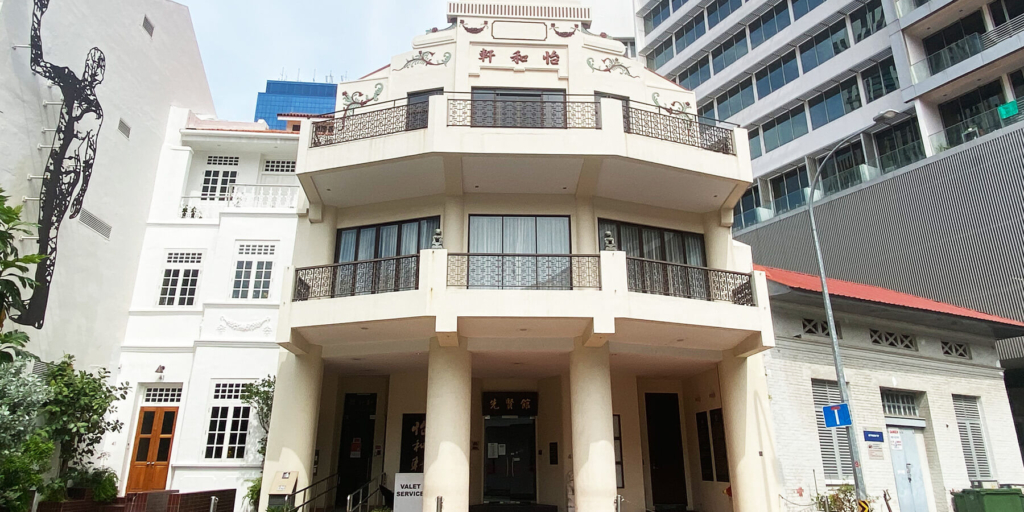
Address: 43 Bukit Pasoh Road
Old Shophouses In Singapore: The club founded in 1895 by a group of Hokkien community leaders for the wealthy Chinese elite. More than a social and business club, its members actively involved in the political development of China in the early 20th century. It supported the 1911 Xinhai Revolution which overthrew the Qing Dynasty, leading to the establishment of the Republic of China. In fact, during World War II, it was the headquarters of the antiJapanese China Salvation Movement in Southeast Asia. The ground floor Pioneers’ Gallery is open for visit and entry is free.
4.Old Shophouses In Singapore: Chin Kang Huay Kuan 晋江会馆
Address: 29 Bukit Pasoh Road
This association established in 1918 by immigrants from Jinjiang County in southern Fujian, China. The current building contrasts with its ornately decorated neighbors. Besides, the use of straight lines, concrete ledges, and mild steel-framed windows are typical of the Modern style that was popular from the 1950s to the early 1970s. During World War II, the building used by the Overseas Chinese General Mobilisation Council which helped the British in supplying laborers and volunteers for the defense of Singapore.
Old Shophouses In Singapore: Tanjong Pagar
Tanjong Pagar in Malay means Cape of Stakes, a name which reflects its origin as the site of a fishing village. It was with the opening of docks nearby in the mid-19th century that accelerated the development of the area due to its location between the docks and town. Today, the area is popular with eateries, entertainment joints, and wedding boutiques.
1.Former Eng Aun Tong 旧永安堂
Address: 89 Neil Road
Eng Aun Tong (Hall of Everlasting Peace) built by Aw Boon Haw in the 1920s as a factory to produce the internationally renowned Tiger Balm. This is one of the few flat-roofed buildings from before World War II. On the roof is a six-sided pavilion, a reference to the six-sided glass bottle that Tiger Balm sold in.
2.Old Shophouses In Singapore: 9 Neil Road
Between 1987 and 1988, 32 dilapidated shophouses of a hybrid Hokkien-Teochew style restored by the Urban Redevelopment Authority. The first-ever project undertaken by the government to demonstrate to the private sector that it was technically possible and commercially viable to restore Singapore’s heritage buildings to their former glory. The first unit to restore – 9 Neil Road and converted into a teahouse which hosted Queen Elizabeth II on her State visit in 1989.
3.Jinrikisha Station 人力车站
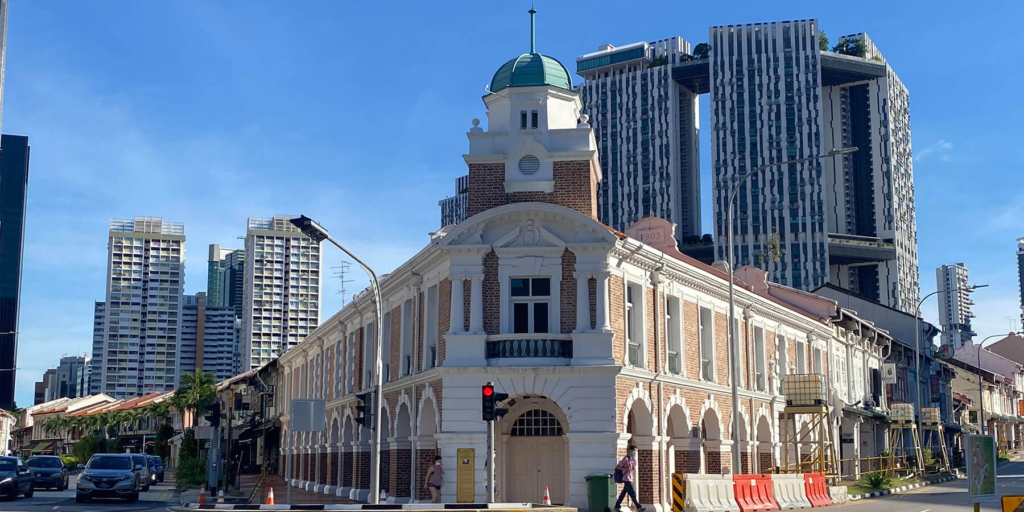
Address: 1 Neil Road
The building built in 1903 by the Municipal Council as the administration centre for rickshaws, a form of
transportation imported from Japan via Shanghai in the 1880s. It is of the Edwardian style, where the exposed
brickwork contrasted with white plaster moldings. Look out for the crest of the Municipal Council at the front of the building, featuring a lion standing on an island with a palm tree.
4.Old Shophouses In Singapore: Former Jing Hwa Cinema 旧金华戏院
Address: 1 Tanjong Pagar Road
Old Shophouses In Singapore: Together with the Majestic and the Oriental, Jing Hwa Cinema. Built-in 1958, was one of Chinatown’s three famous cinemas. It designed by local architect Wong Foo Nam in the Modern style and was the first to have a basement carpark and extensive floor-to-ceiling windows. It remembered fondly by many as the venue of romantic first dates and holiday treats.
5.Murray Terrace
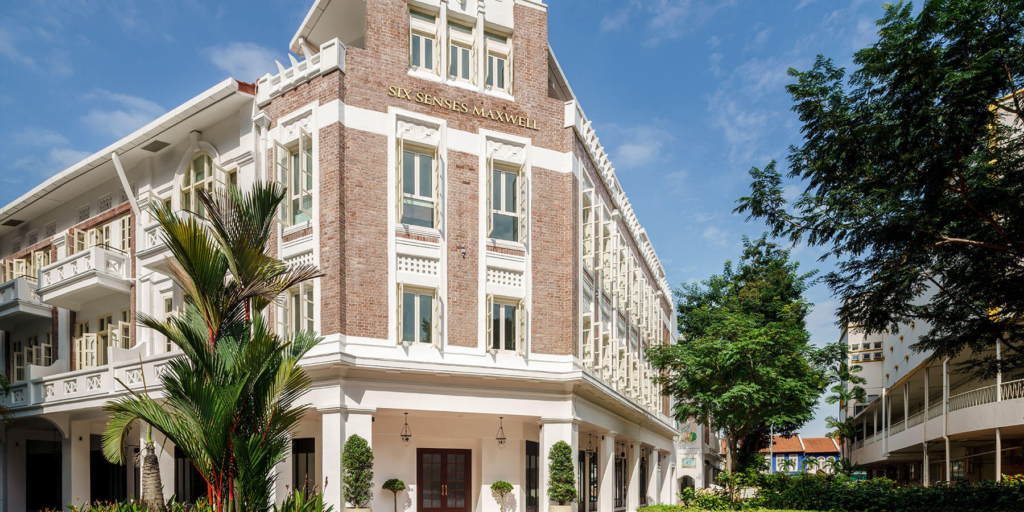
Address: 2 to 28 Murray Street
Built-in 1929, this Art Deco street block has exposed brickwork and unique lion head rain spouts. In 1977, instead of urban renewal through demolition and rebuilding, the Urban Redevelopment Authority pioneered the rehabilitation of the then State-owned property for adaptive reuse. Along with other rehabilitation projects at Tudor Court and Emerald Hill, these buildings were the forerunners of Singapore’s conservation program that was to start in 1989.
6.Old Shophouses In Singapore: Former Custom House
Address: 32 Maxwell Road
This Neo-Classical style building with unique sun-ray molded panels and staggered corner built-in 1932 to house the Department of Customs and Excise, Film Censor’s Office, and Maxwell Road Post Office. When the Singapore Customs moved out in 1989, it put to commercial use and renamed the White House, a name many Singaporeans still remember the building by. Source: URA


